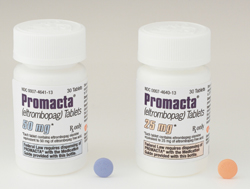Product
Promacta (eltrombopag)
Approval Date
Nov. 20, 2008
Company
GlaxoSmithKline (GSK)
Class
Oral thrombopoietin receptor agonist
Indication
For the treatment of thrombocytopenia in patients with chronic immune idiopathic thrombocytopenic purpura (ITP).
Active Ingredient
Eltrombopag olamine is a biphenyl hydrazone. The chemical name for eltrombopag olamine is 3′-{(2Z)-2-[1-(3,4-dimethylphenyl)-3-methyl-5-oxo-1,5-dihydro-4H-pyrazol-4-ylidene]hydrazino}-2′-hydroxy-3-biphenylcarboxylic acid – 2-aminoethanol (1:2). It has the molecular formula C25H22N4O4.2(C2H7NO). The molecular weight is 564.65 for eltrombopag olamine and 442.5 for eltrombopag free acid.
Agency Roster
Draftfcb Healthcare
Also in the Pipeline (courtesy of Adis R&D Insight)
Drug: LGD 4665
Manufacturer: Ligand Pharmaceuticals
Indication: Thrombocytopenia
Active ingredient: TPO mimetic
Phase: II
Source: WoltersKluwer Health
Recent MM&M Coverage
GSK blood drug works same as placebo: FDA
The Top 60: Draftfcb Healthcare
GlaxoSmithKline plans launch of five new cancer drugs by 2010
Pharmacology
Eltrombopag is an orally active thrombopoietin (TPO) receptor agonist that stimulates the proliferation and differentiation of megakaryocytes from bone marrow progenitor cells. It works by interacting with the thrombopoietin receptor to cause increased platelet production.
Clinical Trials
Two studies were conducted to evaluate the safety and efficacy of eltrombopag in treating chronic ITP. Patients who had completed at least one prior ITP therapy and who had a platelet count of <30×109/L were randomized to either eltrombopag or placebo daily for up to 6 weeks, then 6 weeks off therapy. The primary endpoint was the response rate, defined as a shift from baseline platelet count to =50×109/L at any time during treatment. The groups given eltrombopag 50mg/day had response rates of 59% and 70% in Studies 1 and 2, respectively; for those given placebo, the rates were 16% and 11%.
Adverse Reactions
Nausea, vomiting, menorrhagia, myalgia, paresthesia, cataract, ecchymosis, thrombocytopenia, increased ALT/AST, conjunctival hemorrhage, increased risk of hematologic malignancies; thrombotic events with excessive increases in platelet counts; worsened thrombocytopenia after discontinuation.
Adults
Take on empty stomach. Initially 50mg once daily. Moderate to severe hepatic impairment or East Asian ancestry: initially 25mg once daily. Titrate to maintain platelet count =50×109/L; max 75mg once daily. Adjust dose based on platelet count: see literature.
Children
Not recommended.
Precautions
Monitor CBC, platelet count, and peripheral blood smears for cytopenias and abnormal morphologies; discontinue if no increase in platelet count occurs after 4 weeks at max dose, or if excessive increase in platelet count occurs (eg, >400×109/L), or if evidence of bone marrow fibrosis occurs (eg, cytopenias, nucleated RBCs). Monitor liver function closely before, during, and after treatment (see literature); discontinue if ALT >3xULN and is progressive or persistent for =4 weeks, or if it occurs with evidence of hepatic injury; reinitiation of therapy: not recommended; if restarted, use lower dose and monitor carefully. Do baseline eye exam; monitor for cataracts. Thromboembolism risk factors. Myelodysplastic syndromes. Renal impairment. Pregnancy (Cat.C). Nursing mothers: not recommended.
Interactions
Do not take within 4 hours of food/drugs containing polyvalent cations (eg, Fe+2, Ca+2, Al+2, Mg+2, Se+2, Zn+2). May potentiate substrates of organic anion transporter polypeptide 1B1 (eg, benzylpenicillin, most statins, methotrexate, nateglinide, repaglinide, rifampin); monitor and consider reducing their doses. May be potentiated by strong inhibitors of CYP1A2 (eg, ciprofloxacin, fluvoxamine) or CYP2C8 (eg, gemfibrozil, trimethoprim), and with moderate or strong inhibitors of UGT1A1 or UGT1A3.








